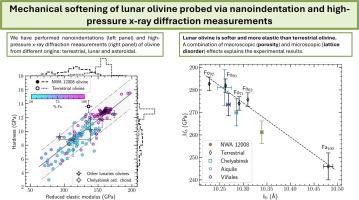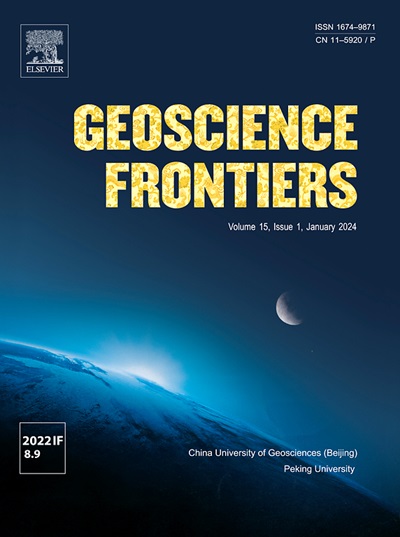Mechanical softening of lunar olivine probed via nanoindentation and high-pressure X-ray diffraction measurements
IF 8.9
1区 地球科学
Q1 GEOSCIENCES, MULTIDISCIPLINARY
引用次数: 0
Abstract
The mechanical properties of minerals in planetary materials are not only interesting from a fundamental point of view but also critical to the development of future space missions. Here we present nanoindentation experiments to evaluate the hardness and reduced elastic modulus of olivine, (Mg, Fe)2SiO4, in meteorite NWA 12008, a lunar basalt. Our experiments suggest that the olivine grains in this lunaite are softer and more elastic than their terrestrial counterparts. Also, we have performed synchrotron-based high-pressure X-ray diffraction (HP-XRD) measurements to probe the compressibility properties of olivine in this meteorite and, for comparison purposes, of three ordinary chondrites. The HP-XRD results suggest that the axial compressibility of the orthorhombic b lattice parameter of olivine relative to terrestrial olivine is higher in NWA 12008 and also in the highly-shocked Chelyabinsk meteorite. The origin of the observed differences is discussed. A simple model combining the results of both our nanoindentation and HP-XRD measurements allows us to describe the contribution of macroscopic and chemical-bond related effects, both of which are necessary to reproduce the observed elastic modulus softening. Such joint analysis of the mechanical and elastic properties of meteorites and returned samples opens up a new avenue for characterizing these highly interesting materials.

通过纳米压痕和高压x射线衍射测量探测月球橄榄石的机械软化
行星材料中矿物的机械特性不仅从基本观点来看是有趣的,而且对未来空间任务的发展也是至关重要的。本文通过纳米压痕实验,研究了月球玄武岩NWA 12008中橄榄石(Mg, Fe)2SiO4的硬度和还原弹性模量。我们的实验表明,这块月球石中的橄榄石颗粒比陆地上的橄榄石颗粒更柔软、更有弹性。此外,我们还进行了基于同步加速器的高压x射线衍射(HP-XRD)测量,以探测该陨石中橄榄石的可压缩性,并与三颗普通球粒陨石进行比较。HP-XRD结果表明,在NWA 12008和车里雅宾斯克高震陨石中,橄榄石的正交b晶格参数的轴向压缩性相对于陆生橄榄石更高。讨论了所观察到的差异的来源。一个简单的模型结合了我们的纳米压痕和HP-XRD测量结果,使我们能够描述宏观和化学键相关效应的贡献,这两者都是重现所观察到的弹性模量软化所必需的。这种对陨石和返回样品的机械和弹性特性的联合分析为表征这些非常有趣的材料开辟了一条新的途径。
本文章由计算机程序翻译,如有差异,请以英文原文为准。
求助全文
约1分钟内获得全文
求助全文
来源期刊

Geoscience frontiers
Earth and Planetary Sciences-General Earth and Planetary Sciences
CiteScore
17.80
自引率
3.40%
发文量
147
审稿时长
35 days
期刊介绍:
Geoscience Frontiers (GSF) is the Journal of China University of Geosciences (Beijing) and Peking University. It publishes peer-reviewed research articles and reviews in interdisciplinary fields of Earth and Planetary Sciences. GSF covers various research areas including petrology and geochemistry, lithospheric architecture and mantle dynamics, global tectonics, economic geology and fuel exploration, geophysics, stratigraphy and paleontology, environmental and engineering geology, astrogeology, and the nexus of resources-energy-emissions-climate under Sustainable Development Goals. The journal aims to bridge innovative, provocative, and challenging concepts and models in these fields, providing insights on correlations and evolution.
 求助内容:
求助内容: 应助结果提醒方式:
应助结果提醒方式:


